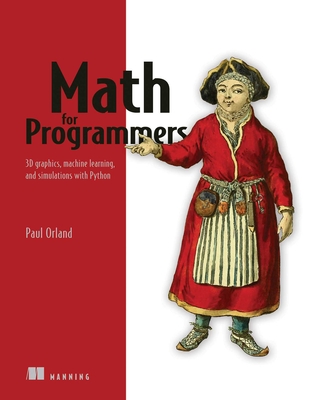Linux Programming by Example
暫譯: Linux 範例程式設計
Arnold Robbins
- 出版商: Prentice Hall
- 出版日期: 2004-04-12
- 售價: $1,740
- 貴賓價: 9.5 折 $1,653
- 語言: 英文
- 頁數: 720
- 裝訂: Paperback
- ISBN: 0131429647
- ISBN-13: 9780131429642
-
相關分類:
Linux
已絕版
買這商品的人也買了...
-
 計算機組織與設計--軟硬體界面第二版 (Computer Organization & Design, 2/e)
計算機組織與設計--軟硬體界面第二版 (Computer Organization & Design, 2/e)$680$537 -
 C++ Primer, 3/e 中文版
C++ Primer, 3/e 中文版$980$774 -
 ASP.NET 網頁製作教本─從基本語法學起
ASP.NET 網頁製作教本─從基本語法學起$600$510 -
 LPI Linux 資格檢定 (LPI Linux Certification in a Nutshell)
LPI Linux 資格檢定 (LPI Linux Certification in a Nutshell)$880$695 -
 Sun Certified Programmer & Developer for Java 2 Study Guide, 2/e
Sun Certified Programmer & Developer for Java 2 Study Guide, 2/e$1,830$1,739 -
 ASP.NET 程式設計徹底研究
ASP.NET 程式設計徹底研究$590$466 -
 重構─改善既有程式的設計
重構─改善既有程式的設計$720$569 -
 鳥哥的 Linux 私房菜-伺服器架設篇
鳥哥的 Linux 私房菜-伺服器架設篇$750$638 -
 鳥哥的 Linux 私房菜─基礎學習篇增訂版
鳥哥的 Linux 私房菜─基礎學習篇增訂版$560$476 -
 CCNA Self-Study: Interconnecting Cisco Network Devices (ICND) 640-811, 640-801, 2/e
CCNA Self-Study: Interconnecting Cisco Network Devices (ICND) 640-811, 640-801, 2/e$2,260$2,147 -
 Dreamweaver MX 2004 魔法書中文版
Dreamweaver MX 2004 魔法書中文版$490$417 -
 SCJP‧SCJD 專業認證指南 (Sun Certified Programmer & Developer for Java 2 #310-305 與310-027)
SCJP‧SCJD 專業認證指南 (Sun Certified Programmer & Developer for Java 2 #310-305 與310-027)$850$723 -
 人月神話:軟體專案管理之道 (20 週年紀念版)(The Mythical Man-Month: Essays on Software Engineering, Anniversary Edition, 2/e)
人月神話:軟體專案管理之道 (20 週年紀念版)(The Mythical Man-Month: Essays on Software Engineering, Anniversary Edition, 2/e)$480$379 -
 JSP 2.0 技術手冊
JSP 2.0 技術手冊$750$593 -
 建構嵌入式 Linux 系統
建構嵌入式 Linux 系統$780$616 -
 CCNA 認證教戰手冊 Exam 640-801 (CCNA Cisco Certified Network Associate Study Guide, 4/e)
CCNA 認證教戰手冊 Exam 640-801 (CCNA Cisco Certified Network Associate Study Guide, 4/e)$780$663 -
 JSP 與 Servlet 500 個應用範例技巧大全集
JSP 與 Servlet 500 個應用範例技巧大全集$590$460 -
 最新 JavaScript 完整語法參考辭典 第三版
最新 JavaScript 完整語法參考辭典 第三版$490$382 -
 Windows 驅動程式設計指南 (Programming the Microsoft Windows Driver Model, 2/e)
Windows 驅動程式設計指南 (Programming the Microsoft Windows Driver Model, 2/e)$890$703 -
 Word 排版藝術
Word 排版藝術$620$490 -
 Eclipse 整合開發工具 (Eclipse)
Eclipse 整合開發工具 (Eclipse)$540$427 -
 Windows 程式設計使用 MFC (Programming Windows with MFC, 2/e)
Windows 程式設計使用 MFC (Programming Windows with MFC, 2/e)$990$782 -
 RFID 技術與應用
RFID 技術與應用$480$408 -
 ASP.NET 徹底研究進階技巧─高階技巧與控制項實作
ASP.NET 徹底研究進階技巧─高階技巧與控制項實作$650$507 -
 世界是平的 (The World Is Flat)
世界是平的 (The World Is Flat)$390$332
相關主題
商品描述
| Description: |
|
Appropriate for all entry-level Linux and Unix programming courses. This book teaches Linux programming in one of the most effective ways possible: by showing and explaining well-written programs. Arnold Robbins focuses on the fundamental Linux system call APIs that form the core of any significant program, and presents code from production programs that Linux and Unix users already work with every day, ranging from Unix source code to GNU utilities such as ls and cp. The topics and APIs covered include: memory management; file I/O, file meta-information, processes, users and groups, sorting, argument parsing, extended interfaces, internationalization, debugging, and more. Robbins stresses fundamental programming principles, and often presents both higher-level and lower-level approaches to key tasks, helping students understand how things work “under the hood.” He also demonstrates how to address the real-world issues that arise in writing software—notably performance, portability, and robustness. All code examples are downloadable from a companion Web site, and most apply equally well to both Linux and Unix. Where differences exist, the author notes them. Linux Programming by Example: The Fundamentals is intended for students who already understand the basics of C and/or C++ |
Preface.
Table of Contents:
Acknowledgments.
1. Introduction.
2. Arguments, Options, and the Environment
3. User-Level Memory Management
4. Files and File I/O.
5. Directories and File Metadata.
6. General Library Interfaces - Part 1
7. Putting It All Together: ls.
8. Filesystems and Directory Walks.
9. Process Management and Pipes.
10. Signals.
11. User and Group ID Numbers and Permissions.
12. General Library Interfaces - Part 2.
13. Internationalization and Localization.
14. Extended Interfaces.
15. Debugging.
16. Tying It Together - A Project.
Appendix A. Teach Yourself Programming in Ten Years.
Appendix B. Caldera Ancient UNIX License.
Appendix C. GNU General Public License.
Preamble.
Terms and Conditions for Copying, Distribution and Modification.
How to Apply These Terms to Your New Programs.
Example Use.
Index
商品描述(中文翻譯)
描述:
適合所有入門級的 Linux 和 Unix 程式設計課程。
本書以最有效的方式教授 Linux 程式設計:透過展示和解釋良好編寫的程式。 Arnold Robbins 專注於構成任何重要程式核心的基本 Linux 系統呼叫 API,並展示來自生產程式的程式碼,這些程式碼是 Linux 和 Unix 使用者每天都在使用的,範圍從 Unix 原始碼到 GNU 工具,如 ls 和 cp。所涵蓋的主題和 API 包括:記憶體管理;檔案 I/O、檔案元資訊、進程、使用者和群組、排序、參數解析、擴展介面、國際化、除錯等。Robbins 強調基本的程式設計原則,並經常提供關鍵任務的高階和低階方法,幫助學生理解事物如何在「引擎蓋下」運作。他還展示了如何解決在編寫軟體時出現的現實問題,特別是性能、可攜性和穩健性。所有程式碼範例都可以從伴隨的網站下載,大多數同樣適用於 Linux 和 Unix。當存在差異時,作者會指出它們。Linux Programming by Example: The Fundamentals 旨在針對已經理解 C 和/或 C++ 基礎的學生。
前言。
目錄:
致謝。
1. 介紹。
2. 參數、選項和環境
3. 使用者級記憶體管理
4. 檔案和檔案 I/O。
5. 目錄和檔案元資料。
6. 一般函式庫介面 - 第 1 部分
7. 將所有內容整合:ls。
8. 檔案系統和目錄遍歷。
9. 進程管理和管道。
10. 信號。
11. 使用者和群組 ID 數字及權限。
12. 一般函式庫介面 - 第 2 部分。
13. 國際化和本地化。
14. 擴展介面。
15. 除錯。
16. 整合所有內容 - 一個專案。
附錄 A. 自學程式設計十年。
附錄 B. Caldera 古老的 UNIX 授權。
附錄 C. GNU 通用公共授權。
前言。
複製、分發和修改的條款和條件。
如何將這些條款應用於您的新程式。
範例使用。
索引































